| Overview Electronics, telecommunications equipment and fiber optic connections can be recovered from catastrophic water damage due to hurricanes, floods, fire suppression and other severe water impact situations. Water can be removed using cleaning solutions and processes that target water and trapped moisture. Once the moisture is removed, the assemblies can be cleaned to remove deposited oil and grease, soot, debris and other soils. While water can cause extensive damage, it does not mean that equipment is lost and cannot be replaced. When used with the following procedures, Chemtronics’ products are an efficient and effective tool for the recovery and restoration of electronic and telecommunications equipment. |
| Step 1: Rinse Equipment with Clean Water All the affected equipment should be flushed well with clean water to remove salt, sediment and particulate matter. Flush with water until the rinsate is clear. After the equipment has been rinsed thoroughly, allow to stand and completely drain. Equipment already damaged by water will not be damaged further by the use of clean water. Step 2: Remove Water and Moisture Water and moisture must be removed from all parts and assemblies. This can be effectively accomplished by using Flux-Off Water Soluble (Part No. ES1530). The hydrophilic nature of this solvent attracts moisture and dissolves and carries away water from the parts. The force of the aerosol spray will help dislodge and flush away trapped moisture in addition to excess surface contaminants. Equipment and components can also be dipped into Flux-Off Water-Soluble to remove moisture and contaminants. Coventry Econowipes (part number 6709 or 6704) can be used to aid with cleaning and drying. After using Flux-Off Water Soluble, allow the equipment and assemblies to completely dry. To speed the drying process, use UltraJet Duster (part number ES1020). The high pressure of the UltraJet Duster performs as a “portable compressor” to effectively dry excess moisture and solvent. Step 3: Remove Remaining Contaminants Additional cleaning may be necessary to remove other contaminants and excess moisture. Use Electro-Wash PX Fiber Optic Cleaner (part number ES1210) for plasticsafe cleaning. Spray equipment thoroughly and then allow to dry completely. Make sure all contaminated areas have been sprayed and completely cleaned. Use Coventry Econowipes (part number 6709 or 6704) to aid with cleaning and drying. To speed the drying process, use UltraJet All-Way Duster (part number ES1620) to remove the remaining solvent from components. Use Chemtronics DPL Deep Penetrating Lubricant (part number ES1626) to clean and protect copper connections and switches. It is used to clean, displace moisture, inhibit corrosion, reduce friction and protect metal surfaces in one easy step. Step 4: Clean Backplane Connections Cleaning and restoration of backplane connections can be effectively achieved through the use of Chemtronics’ Clean Connection Tools, or with cleaning swabs designed for this purpose. Option 1: Choose the appropriate FOCCUS Clear Connection Tool (CCT) based on the type of fiber connection. CCT Tools are available for 1.25mm, 2.5mm and MPO connections. CCT tools have an easy to use mechanism that advances fabric over a cleaning tip with just a short push and click of the tool. • Remove the dust cap from the end of the CCT tool. • Lightly wet the CCT fabric tip with a Fiber-Wash pen (Part number FW2150) • Insert the CCT tip directly into the connector. Push in the tool 2-3 clicks, advancing the fabric from wet-to-dry. The fabric rotates while advancing, adding additional cleaning action. • Repeat on the next connector until all connectors have been cleaned. • The end faces of unconnected patch cords can be cleaned by placing the dust cap back onto the end of the CCT tool. The dust cap becomes an adapter that fits directly over the ferrule of the connector. • Test connector with a fiberscope and, if necessary, repeat cleaning procedure. Option 2: This method is preferred when contamination is substantial. Use the appropriate swab and a small amount of Electro-Wash PX Fiber Optic cleaner (aerosol) or Fiber-Wash MX Precision Cleaner Pen (part number FW2150). • Use the Coventry 48040 swab for cleaning 2.5 mm connections and the Coventry 25123X swab for 1.25 mm connections. • Spray a small amount of the Electro-Wash PX onto a clean QbE wipe or another clean lint-free wiper (Coventry 6704 Econowipe). Dampen the swab by lightly touching the swab head to the moistened area. Do not over saturate the swab head. • Optionally, saturate the felt tip of the Fiber-Wash MX pen by depressing it onto a clean wipe. Dampen the swab by touching it to the pen tip. • Feed the moistened swab tip through the alignment sleeve to clean the backplane connection, Repeat procedure a second time using a dry swab. The use of this process allows the first moistened swab to remove all types of contaminants while eliminating the static bond that holds contaminants to the end-face. The second dry swab removes any remaining solvent. • Test connector with a fiberscope and, if necessary, repeat cleaning procedure. Step 5: Clean FO Connections With the Combination Cleaning procedure Use the QbE cleaning system in combination with Electo-Wash PX Fiber Optic Cleaner to remove contaminants from connector end-face. The large surface area of the QbE system allows both standard and APC connectors to be cleaned with the same tool. Use the following procedure to clean connector end-face. • Pull one QbE wipe from the box over the neoprene platen. • Spray a small spot (about quarter-size) of Electro-Wash PX onto one corner of the wipe • Optionally saturate the corner of the wipe with Fiber-Wash MX pen (Part number FW2150) • Move the end-face of the connector from the wet area of the QbE lightly across the dry portion of the pad. Make sure to hold the end-face at 90º perpendicular to the platen. • Repeat the wet to dry cleaning motion two more times, and make sure not to retrace your cleaning procedure of previously used areas of the wipe. • Test connector with a fiberscope and, if necessary, repeat cleaning procedure. Clean the barrel of the ceramic ferrule using a Coventry 38540 swab moistened with Electro-Wash PX Fiber Optic Cleaner. Spray a small amount of Electro-Wash PX onto a clean QbE wipe. Lightly moisten one side of the swab on the damp portion of the QbE. Rotate the wet side of the swab on the ceramic ferrule 2 to 3 times. Reverse the swab and rotate the dry side of the swab on the ceramic ferrule 2 to 3 times. |
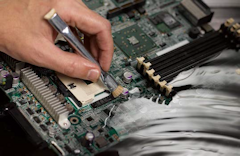 Step 1: Rinse with clean water 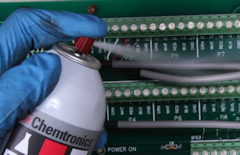 Step 2: Remove moisture with Flux-Off Water Soluble cleaner and UltraJet Duster 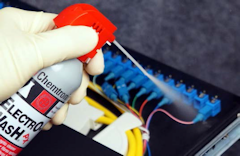 Step 3: Clean with Electro-Wash PX 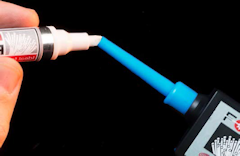 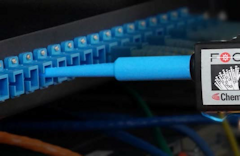 Step 4.1: Wet tip of CCT tool and clean fiber optic connectors 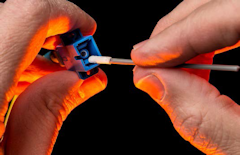 Step 4.2: Clean fiber optic connectors with 1.25 and 2.5mm swabs 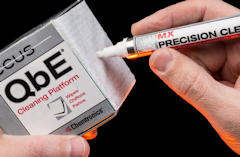 Step 5.1: Saturate wipe with Fiber-Wash MX Pen |
